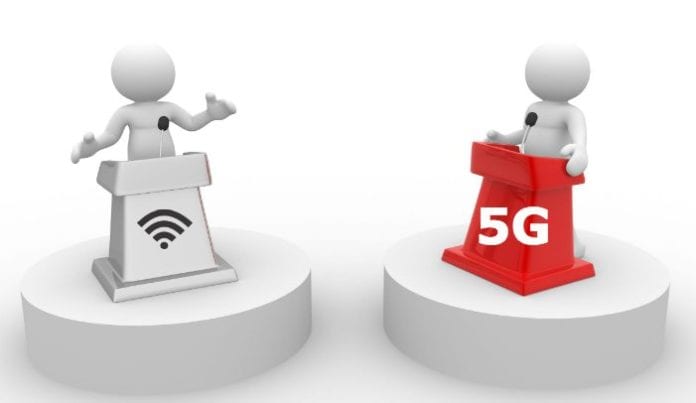Did you know that 5G is going to replace Wi-Fi in the near future? That might sound like a fact for regular readers of the more hyperbolic commentary on the so-called 5G vs. Wi-Fi debate. But the truth is always more grounded than the hype, and in reality Wi-Fi and cellular each have their own unique attributes and will co-exist for the foreseeable future.
So much of today’s discussion around these two technologies is reminiscent of what happened when cloud computing first emerged. Soon after, we heard how cloud would replace on-premises computing altogether, and oversimplified narratives that left no room for nuance created swirl in the marketplace. We’re seeing the same type of phenomena happening now, but there is no zero-sum game with 5G and Wi-Fi. Between long-haul and last mile, optical and ethernet, wired and wireless — moving data has never had a one-size-fits-all solution, and it won’t start now.
Different jobs require different tools, and there are a number of areas where both Wi-Fi and 5G excel. One of the best use cases for Wi-Fi is connecting the ever-growing number of Wi-Fi only devices. Consider the example of Forsyth County School District in Georgia. As one of the fastest growing districts in the state, their network supports 100,000 unique devices each day — smartphones, laptops, tablets, smartboards, security cameras and more. Equipping every single device with cellular technology would make no sense. Similarly, if this school district – or any organization – has bandwidth-intensive needs such as streaming video or transferring large files, then Wi-Fi is a faster and more reliable option. Not to mention that doing this over 5G would lead to a shocking bill for an average school district.
Other benefits from Wi-Fi don’t necessarily come from the technology itself, but from ownership over it. An organization that provides Wi-Fi is able to glean real-time, analytic insights from their own network. This is beneficial from an IT perspective, as it helps identify and solve any network issues that arise, but it can also add real business value. A retailer providing free Wi-Fi to its customers can analyze and use the data generated to engage with shoppers and analyze their behavior to optimize services – not the case if using a mobile carrier, who would own that data and make analysis difficult. Wi-Fi’s evolution also allows those deploying networks to enhance their security posture, and new standards like WPA3, a prerequisite for Wi-Fi 6, are bringing new capabilities to keep networks safe.
On the other hand, there is no dismissing the benefits of 5G. Cellular technology is going to be the driving force behind the smart car and smart city revolution. Anything that requires constant connectivity over large geographic areas will require 5G to function – a self-driving car can’t hop onto free public Wi-Fi. The speed, throughput and coverage density of 5G will connect entire cities, and that underlying infrastructure will serve as the basis for any number of “smart” innovations.
It is also hard to beat 5G when it comes to convenience. The ability to outsource connectivity to a massive third-party provider, and receive high-quality service in return, is a very appealing proposition. And while the benefits of operating a Wi-Fi network include control, analytics and increased options on security, those all come with costs and labor requirements that 5G does not have.
Finally, if there’s one use case where Wi-Fi can’t catch up to 5G no matter how hard it tries, it’s voice. Over the years, Wi-Fi has improved quality of service when it comes to supporting voice, but cellular was engineered from the beginning to support real-time voice communications and 5G is simply better than what has come before it. This is most true when it comes to range – Wi-Fi can deliver voice experiences successfully in a confined space, like an office, but cellular is the only technology that can deliver quality everywhere.
The dual use cases – our path forward
Cutting through the hype, it’s clear that both of these technologies bring value to the table, and that value is increased through smart deployment of both 5G and Wi-Fi. For example, new Wi-Fi 6-enabled access points are coming online this year, and carriers can use those to handle offload in 5G networks. Similarly, the demands of 5G are forcing carriers to rethink backhaul operations, and while fiber is the current choice today, a recent Ericsson report found that 40% of backhaul connections are expected to be based on wireless technology by 2023.
And then there’s the future. The combination of these two technologies will be a breeding ground for new end-user experiences we haven’t even dreamed of yet. Whether its VR and AR, advanced facial and voice recognition, robotics or another new scenario, the combination approach is going to lead to futuristic experiences in the coming years.
The hype machine isn’t totally wrong – 5G is a gamechanger that has immense potential and will play a key role in transforming connectivity. But what is getting lost in that hype is the impossible-to-overstate role that Wi-Fi currently plays in holding together our institutions and systems. Can you imagine, for example, a hospital going 24 hours without Wi-Fi? Or a school? Or, in a true nightmare scenario, the airport while you’re waiting for a flight? The calls for 5G to simply “replace” Wi-Fi are both misplaced — and unrealistic. In our view, the vast majority of scenarios will involve both technologies and we’ll all be better for it.

